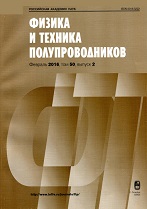|
This article is cited in 1 scientific paper (total in 1 paper)
Manufacturing, processing, testing of materials and structures
Application of high-frequency EPR spectroscopy for the identification and separation of nitrogen and vanadium sites in silicon carbide crystals and heterostructures
E. V. Edinach, A. D. Krivoruchko, A. S. Gurin, M. V. Muzafarova, I. V. Il'in, R. A. Babunts, N. G. Romanov, A. G. Badalyan, P. G. Baranov
Ioffe Institute, St. Petersburg
Abstract:
The advantage of the high-frequency spectroscopy of electron paramagnetic resonance (EPR) for the identification of nitrogen donors and a deep compensating vanadium impurity in various crystallographic positions of the silicon-carbide crystal is shown. Measurements are performed using a new generation EPR spectrometer operating in the continuous wave and pulsed modes at frequencies of 94 and 130 GHz in a wide range of magnetic fields (-7–7 T) and temperatures (1.5–300 K). A magneto-optical closed-cycle cryogenic system (Spectormag PT), highly stable generators (94 and 130 GHz), and a cavity-free system for supplying microwave power to the sample are used.
Keywords:
electron paramagnetic resonance, electron spin echo, semiconductors, silicon carbide, donor impurities.
Received: 02.08.2019
Revised: 12.08.2019
Accepted: 12.08.2019
Citation:
E. V. Edinach, A. D. Krivoruchko, A. S. Gurin, M. V. Muzafarova, I. V. Il'in, R. A. Babunts, N. G. Romanov, A. G. Badalyan, P. G. Baranov, “Application of high-frequency EPR spectroscopy for the identification and separation of nitrogen and vanadium sites in silicon carbide crystals and heterostructures”, Fizika i Tekhnika Poluprovodnikov, 54:1 (2020), 103–110; Semiconductors, 54:1 (2020), 150–156
Linking options:
https://www.mathnet.ru/eng/phts5316 https://www.mathnet.ru/eng/phts/v54/i1/p103
|


| Statistics & downloads: |
| Abstract page: | 62 | | Full-text PDF : | 28 |
|





 Contact us:
Contact us: Terms of Use
Terms of Use
 Registration to the website
Registration to the website Logotypes
Logotypes








 Citation in format
Citation in format 
